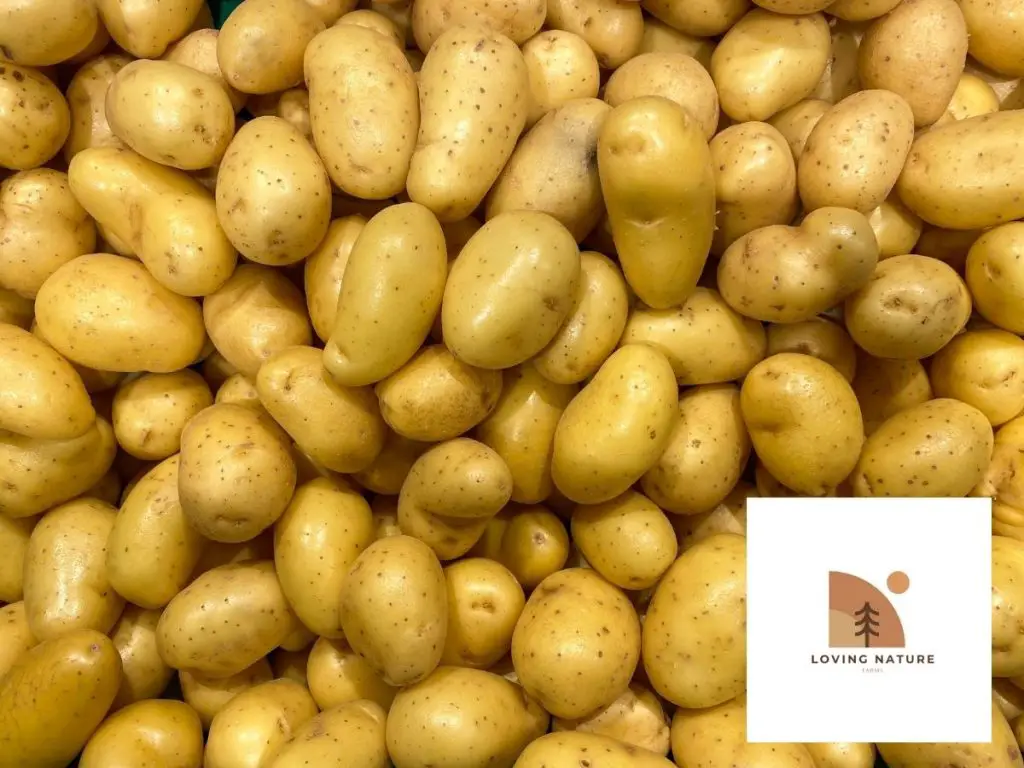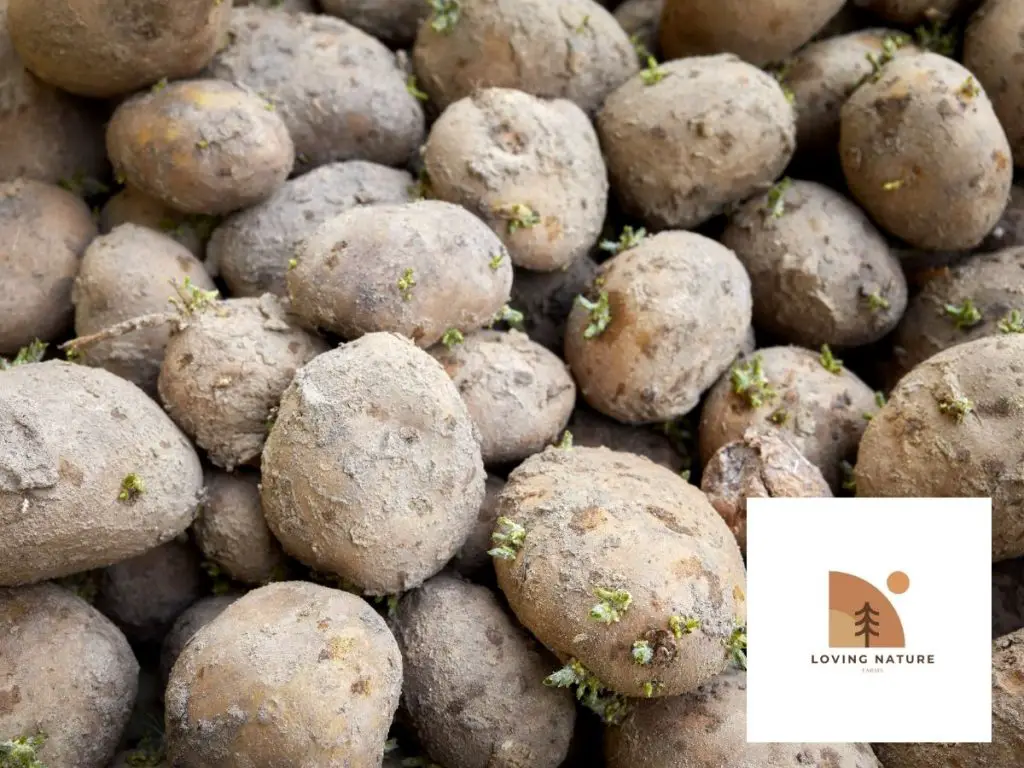No one wants to eat a bad potato. It’s not only unappetizing, but it can also make you sick. In this article, we will discuss 13 ways to tell if a potato is spoiled. If you follow these tips, you’ll never have to worry about eating a bad potato again!
The first thing to look for when eating a potato is if it smells bad. A fresh potato will have a distinctive earthy smell, similar to other root vegetables. If you detect any signs of mold or mildew, you will not want to eat it. If the potato has a musty or sour smell, you should not eat it either. Luckily, there are some easy ways to tell if your potato is bad.

Symptoms of botulism
Symptoms of botulism in potatoes can be difficult to detect, but it can occur in just a handful of cases every year. The toxin prevents communication between the nerves and can lead to difficulty swallowing, facial weakness, blurred vision, drooping eyelids, and respiratory difficulties. Some people even experience paralysis. In order to avoid experiencing symptoms, potatoes should be stored in the refrigerator for at least three days after cooking. While fruits and vegetables do not typically need to be refrigerated, they can be safely stored for up to four days.
To minimize the risk of the toxin spreading to the rest of your food, bake potatoes in foil to seal in the moisture. Potatoes can become infected with the toxin when wrapped in aluminum foil. Potatoes can become contaminated with botulism spores during the cooking process, and the tightly wrapped aluminum foil creates a damp, anaerobic environment where the toxin can germinate and cause symptoms.
One recent case of botulism in potatoes is based on a baked potato. A man from Ontario, Canada, was paralyzed and temporarily lost his eyesight after consuming a contaminated potato. While he remains on life support, his wife says that he’s still able to blink and squeeze her hand. However, botulism symptoms can be deadly if left untreated.
Symptoms of mold
You may notice a white, fungus-like mold on your potatoes. This type of mold is harmful to health and should be avoided. Molds on potatoes are most common on damaged portions of the potato. In addition, a bitter potato means that it is rotten and contains high levels of solanine. In addition, this type of mold is caused by a fungus known as sclerotinia stem rot. This fungus grows in moist conditions, including in fields with overhead irrigation.
A rotten potato is extremely dangerous, as it gives off a gas known as solanine, which can make you unconscious. In fact, there are reports of people dying from ingesting rotting potatoes from root cellars. Potatoes can show symptoms of solanine poisoning, which is rare but can be very dangerous. In addition to symptoms of stomach cramps and fever, people who have eaten rotten potatoes can develop solanine poisoning.
Among the symptoms of this fungus are black rot and lesions on the fleshy storage roots. These lesions continue to enlarge throughout the storage period. In addition, black cankers form on the underground parts of the stem. Depending on the severity of the disease, secondary symptoms include yellowing, stunting, dropping leaves, and wilting. Once the infection has spread throughout the crop, the infection may be more serious.
Symptoms of wrinkly skin
Potatoes age like human skin does. They become wrinkled and mushy over time. While these characteristics won’t affect their taste, they are indications that the tuber is bad. A potato’s smell should be earthy or nutty. It should not be musty, as mushy potatoes aren’t edible. Wrinkly skin on a potato also suggests a problem with its quality.
If you notice wrinkly skin on a potato, it’s time to throw it out. Wrinkled skin on a potato means it’s dehydrated. This is different from decomposing. As potatoes age, their starches begin to convert to sugars, which is what gives them their characteristic taste. Potatoes can still be eaten if they have sprouts on them, but they shouldn’t.
Potatoes that are old and wrinkled can cause diarrhea and sickness. The University of Illinois Extension warns against eating wrinkled potatoes. Wrinkly potatoes produce solanine, a bitter compound that is toxic to the digestive system. In excess, solanine can cause paralysis. Even more important is that a potato’s skin is firm and wrinkle-free. If it is wrinkled or mushy, it should be thrown away.
The brown color on the skin of a potato indicates that it’s infected with a fungus. Symptoms of bacterial soft rot include wrinkly skin, mushy texture, and internal black spots. The latter two are a sign of a potato’s potential to be infected with fusarium. If the fungus has already begun to attack the potato, it’s too late to save it.
Symptoms of mushy skin
If you notice mushy skin on potatoes, you may have a problem with your crop. While some potatoes may still look fine on the outside, they are probably not edible. Potatoes with a mushy skin may have been exposed to too much light, which will make them produce solanine and chlorophyll. This substance has a bitter taste, and when consumed in large quantities, can even cause paralysis.
The cause of mushy skin on potatoes is a soil borne disease caused by a fungus called potato leafroll virus. Symptoms of net necrosis include brownish black dots in the vascular ring and strands of discolored skin throughout the potato tuber. Potatoes with net necrosis are often confused with frost necrosis, and the symptoms of each may be similar. However, the dots and streaks in net necrosis are more distinct and appear in concentric rings.
If you notice mushy skin on potatoes, you should immediately inspect the tuber. You should check for signs of soft rot before harvesting. Infected potatoes have a rubberlike texture and a mushy texture. Infected potatoes are usually cream to tan in color, but can turn brown or black when cut. Initial decay of the tuber is relatively odorless, but the odor will become foul as bacteria multiply. Another possible cause of mushy skin on potatoes is lenticel infection, which occurs in wet soil. Lenticel infections are approximately a half-inch in diameter and may be slightly darker than the skin of the potato.
Symptoms of shriveled skin
Shriveled skin on a potato can mean a number of different things. It could mean a potato has been exposed to excessive light, which can cause it to turn green. The most common culprits for this are fluorescent lights and sunlight. The light can break down the potato’s natural defenses against rot, making it bitter. A good way to avoid green potatoes is to store them in cool, dark places.
A shriveled skin on a potato may be caused by a fungus called H. solani. The fungus attacks the periderm on the tuber, but has not yet spread to the roots, stolons, or stems. When the potato is infected, it can take anywhere from three to five weeks for lesions to develop. Symptoms can be difficult to detect until the potatoes are harvested.
Shrinkled skin on a potato may be a sign of a variety of potato diseases, including fusarium dry rot, which causes internal, dark brown rot. The disease may start at an injury site and spread, or it can completely rot the tuber. As the rotting progresses, the tissues shrink and collapse. The symptoms of fusarium dry rot are almost identical to early blight. The difference between the two is that fusarium dry rot produces tiny black sclerotia.
Regardless of the cause, if your potato has wrinkled skin, it is in danger of containing glycoalkaloids, which are toxins found in potatoes. They may cause digestive problems, resulting in unpleasant taste and a risk of food poisoning. As a result, you should always avoid sprouted potatoes and discard any that have wrinkled skin. While wrinkling potatoes do not have a disease, they should be discarded because they could be harmful if consumed.
Symptoms of rotting skin
When it comes to identifying rotting potatoes, the first symptom to look for is wilting. This symptom is most often associated with tuber rot, but it can also occur on the plant’s roots. In more severe cases, the potato may completely rot and its skin may crack. The disease spreads via vascular infection of daughter tubers that develop from an infected seed. The fungus cannot overwinter in soil, but it can survive on debris from infected crops and groundkeepers.
Postharvest losses from rotting skin on potatoes are widespread, and the most common cause is fusarium dry rot. This disease affects both seed potatoes for human consumption. The rotted area appears brown, and the skin becomes wrinkled. It can also cause seed potatoes to rot before planting. If you notice this fungus, call your local extension office or farmer’s market to see if your potatoes are affected.
If you notice any of these symptoms, you should begin preventing the disease by buying potatoes that are certified disease-free. Then, you should carefully inspect the seed pieces yourself. Store seed potatoes at a temperature of forty to forty-two degrees Fahrenheit and gently warm them to fifty degrees before harvesting. Cold temperatures inhibit Fusarium growth, but warm temperatures promote healing of the potato tuber. When harvesting potatoes, always use sharp blades and never leave a “cull pile” of tubers.

Others Ways To Tell Before Eating That Bad Potato
Signs Of Age
Potato skin, like human skin, sags, creases, and develops dark spots with age. Such anomalies are a warning that the potato is no longer in its best shape. It won’t have an effect on the taste of the potato.
When to bin it: To avoid contaminating other potatoes, discard the potato if it has already sagged, wrinkled, and/or feels mushy. In order for this sort of condition to persist, the potato should not be consumed anymore.
Again The Smell
Fresh potatoes should have an earthy, nutty, and starchy aroma. A potato will have a harsh, musty, and moldy scent once it begins to decay.
It’s sometimes difficult to tell whether a potato is still good since the outside may appear nice, but the inside has already rotted.
As a result, before purchasing potatoes, it is critical to smell them. Don’t buy it if the odor is different.
If you haven’t yet purchased the potato, examine it to see if only a tiny portion of it is tainted.
Remember, a single damaged area does not necessitate the whole potato’s elimination. You can simply remove the unsavory section and continue eating the rest of the potato.
When to get rid of it: If most, or the entire potato is rotten, throw it out.

What Is That Growing Out Of My Potato?
Potatoes continue to develop long after they have been dug. This is why, when kept for an extended period of time in a humid environment, they produce small sprouts, or “eyes,” which are particularly noticeable.
Usually, this happens to organic potatoes or crops grown in the garden because no pesticides were used to grow them. If the potato still has a pleasant odor, you can eat it. Before cooking, just chop off the sprouts.
Green spots, on the other hand, appear before the shoots and sprouts. When the potato is kept in an area where it receives direct sunlight, green patches may form.
The presence of a toxin called solanine is indicated by the green spots. Small green spots can be removed and discarded, leaving the healthy portion intact.
When to get rid of them: potatoes with long sprouts, folds, and mushy texture should all be discarded.
Potatoes should also be discarded if there are already numerous large green splotches on the skin.
How To Tell If A Cooked Potato Is Bad
What Is That Smell?
A foul-smelling potato dish, as well as mold growth, is an indication of spoilage. Potatoes that have been cooked and still smell bad should not be consumed any longer.
Bacteria can survive on potatoes for days and even weeks after they have been cooked, according to Eat Smart. In some circumstances, uncooked potatoes may already be infested with germs without any obvious symptoms. As a result, it is advised that the meal is consumed within four days after it has been cooked.
Make sure to reheat the meal after you’re finished eating in order to destroy any germs that may have developed on the food.
Why You Shouldn’t Store Your Potatoes In The Fridge
Most people are familiar with the old saying, “If it’s green, don’t eat it.” This sage advice applies to potatoes as well, which is why you should never store them in the fridge. The cool temperature causes the potatoes to produce a chemical called solanine, which give them a green tint and can make them poisonous. In addition, potatoes that are stored in the fridge are more likely to develop a bitter taste. So if you’re looking to keep your potatoes fresh, your best bet is to store them in a cool, dark place like a pantry or cupboard. However, even properly stored potatoes will only last for about two or three weeks. After that, they’ll start to shrivel and develop a mealy texture. So if you find yourself with more potatoes than you can eat in a short period of time, your best bet is to cook them and then freeze them for later. That way, you can enjoy their fresh flavor any time of year.
Where To Store Your Potatoes
The pantry has always been the go-to storage place for potatoes, but is it the best place? As it turns out, the answer is no. Potatoes are best stored in a dark, cool location with plenty of ventilation. The pantry is often too warm and can cause the potatoes to sprout or rot. In addition, lack of ventilation can lead to mold growth. For these reasons, it’s better to store potatoes in a dark closet or in a paper bag in the fridge. By taking these simple steps, you can help ensure that your potatoes stay fresh and delicious.
Freezing Potatoes
Yes, it is possible to freeze potatoes. Cooking and cooling the potatoes before freezing is important in order to prevent nutrient loss and reduce bacterial growth. Once the potatoes are fully cooked, you should allow them to cool completely before packing them into airtight containers or bags. You can then transfer these containers or bags to the freezer for long-term storage. When you are ready to use your frozen potatoes, you can simply transfer them from the freezer to your refrigerator to thaw. Depending on how often you plan on using frozen potatoes, it may be helpful to divide them into smaller portions so that you can defrost only what you need at any given time. Overall, with a little care and planning, freezing potatoes can be a great way to extend the shelf life of this versatile food.
Eating Bad Potatoes
Potatoes are a versatile and delicious staple of many diets around the world. However, if potatoes are not cooked properly, they can pose a serious health risk. Raw potatoes contain solanine, a compound that can cause nausea, vomiting, and diarrhea. In severe cases, solanine poisoning can lead to paralysis and even death. Cooked potatoes that have been allowed to cool and then reheated can also harbor harmful bacteria. For these reasons, it is important to only eat properly cooked potatoes that have been prepared using fresh, uncontaminated ingredients.
Storing Potato Tips
Storing your potatoes properly can help them to last for several months. Here are a few tips to keep in mind:
-Potatoes should be stored in a cool, dark place. A temperature of 45-50 degrees Fahrenheit is ideal.
-Potatoes should not be stored near other fruits and vegetables, as they give off ethylene gas that can cause potatoes to spoil more quickly.
-To prevent potatoes from sprouting, store them in a paper bag or another breathable container. Do not store them in plastic bags, as this will trap moisture and encourage rot.
– Check on your potatoes regularly, and remove any that show signs of spoiled (soft spots, discoloration, mold). These potatoes can still be used if you cut away the spoiled parts, but they will not last as long as healthy potatoes.
By following these tips, you can enjoy fresh potatoes all winter long!
Final Thoughts
Potatoes are a versatile and delicious staple of many diets around the world. However, if potatoes are not cooked properly, they can pose a serious health risk. Raw potatoes contain solanine, a compound that can cause nausea, vomiting, and diarrhea. In severe cases, solanine poisoning can lead to paralysis and even death. Cooked potatoes that have been allowed to cool and then reheated can also harbor harmful bacteria. For these reasons, it is important to only eat properly cooked potatoes that have been prepared using fresh, uncontaminated ingredients.
When storing potatoes, it is important to keep them in a cool, dark place with plenty of ventilation. The pantry is often too warm and humid for potatoes, which can lead to sprouting and rot. The fridge is generally too cold, which can cause the potatoes to develop a sweet taste. A temperature of 45-50 degrees Fahrenheit is ideal. Potatoes should also not be stored near other fruits and vegetables, as they give off ethylene gas that can cause potatoes to spoil more.
Leave a Reply